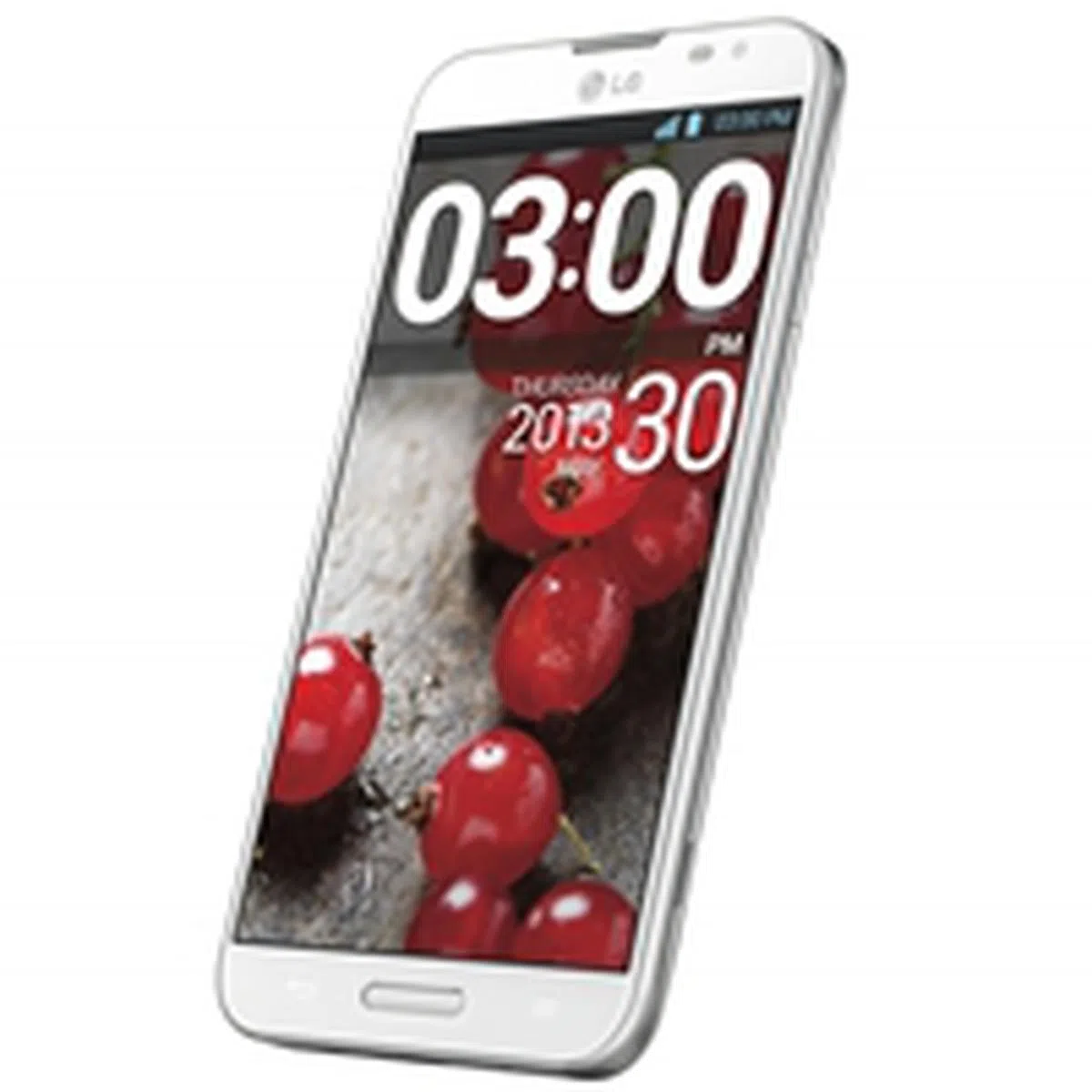LG Optimus G Pro - A Show Stopper?
LG brings the fight to Samsung with its 5.5-inch Optimus G Pro. Equipped with one of the latest quad-core processors and a full HD display, is the LG Optimus G Pro the best phablet you can get today? Read on for our verdict in this review.
By HardwareZone Team -
Overview
LG unveiled the 5.5-inch Optimus G Pro in South Korea on February 18 days before it was showcased at Mobile World Congress 2013 where we had a hands-on session. Back then, LG laid claims to being the first phone announced to be using Qualcomm Snapdragon 600 quad-core processor. It is also one of the few 5.5-inch phones to come with a full HD display.
Now that there are several phones sporting full HD displays and Snapdragon 600 processors in the market, has the LG Optimus G Pro lost its shine? More importantly, is the LG Optimus G Pro a compelling alternative to the nine-month old Samsung Galaxy Note II? Read on to find out more. Here's a quick look at the specs of the LG Optimus G Pro and how it fares against the Samsung Galaxy Note II:
 | Key highlights of the LGOptimus G Pro
|
[hwzcompare]
[products=402206,322014]
[width=250]
[caption=Comparing the LG Optimus G Pro and Samsung Galaxy Note II]
[showprices=1]
[/hwzcompare]
Design
Unlike its 5-inch counterparts, it's hard to find fault with the material used for the chassis of the Optimus G Pro. The use of any other materials (e.g. aluminum) would have made the 5.5-inch device much heavier. At the Asian launch event held on 3 June, Dr. Ramchan Woo, head of LG's smartphone division reiterated the same point and shared that the company is actively researching other materials for use on future phones.
So far, we have only seen one manufacturer succeeding in building a similarly-sized phone with a better build and design - the Lenovo K900. The K900 is encased in a low-magnetic stainless steel and polycarbonate unibody chassis which measures just 6.9mm and weighs only 162g. In comparison, the Optimus G Pro has a side profile of 9.4mm (similar to the Galaxy Note II) and tips the scale at 172g.

The LG Optimus G Pro is almost an exact copy of the Samsung Galaxy Note II except for a slightly shorter, narrower and lighter body.
If you've noticed, the Optimus G Pro has a very thin bezel around its 5.5-inch IPS display. According to LG, the bezel is a mere 3.65mm thin. However, if you look closely at the screen, you can see that there is actually a black frame.
Similar to the Galaxy Note II, the Optimus G Pro comes with a hardware home button flanked by the capacitive back (left) and menu (right) buttons. We find the home button to be a little too thin and and flat for our liking. As a result, you have to apply a bit more effort to press it.
While other phones usually have a dedicated notification LED, LG takes a different approach; the home button acts as the notification LED. Dubbed Smart LED Lighting, the home button lights up in various colors to alert you of missed calls, messages, low battery and other notifications.

You will find the Q Button (shortcut button) and volume controls on the left side of the LG Optimus G Pro. By default, the shortcut button activates the QSlide feature.
There is a shortcut button (also known as the Q button) on the top left side of the device. By default, the Q button activates the QSlide feature. You can customize the Q button to be a shortcut to almost any app on the phone via Settings > QuickButton.

The battery cover is easy to remove and it also gives you access to the micro-SD card slot. Take note that it's hot-swappable, which means that you can insert or remove the card when the phone is powered on - despite the phone's cover not being present.
The handling of the Optimus G Pro proved to be a tricky issue for us. We find its glossy plastic rear cover to be slippery, and coupled with the size of the device, we were in constant fear that the phone would accidentally slip out of our grasp.
Features
The Optimus G Pro runs on Android 4.1.2 Jelly Bean and the latest Optimus user interface, which has unique features that the Optimus G doesn't. Let's take a look at these exclusive features.
Color Emoticons

Color Emoticons for texting in email and SMS - a first for an Android smartphone.
LG claims that this implementation is the first for an Android smartphone where emoticons can be inserted while texting in email and messages. For those who are unaware, there are already several third party keyboards such as Go Keyboard that have support for Emoji.
If the emoticons look familiar, they are actually inspired from the stock emoticons in WhatsApp. Users who message a lot and go beyond simple text will appreciate this feature.
Q Button

The list of apps that can be set as the shortcut for the Q button.
As mentioned in the design section, the Q button allows you to set an app shortcut. Basically, any app that is preloaded or installed on the device can be set as a shortcut. There are five recommended apps by LG to be used which are QuickRemote, QuickMemo, Camera, Internet and Music.
While you cannot jump straight into the app from sleep mode, the Q button allows you to go straight into the app from the lock screen. All you need to do is press and hold the button.
Smart Video

LG's own take of the Smart Pause feature on the Samsung Galaxy S4 is Smart Video, where the Optimus G Pro deploys advanced eye recognition technology to detect the position of the viewer's eyes to determine when to automatically pause the video.
The Smart Video feature functioned as claimed in our day-to-day usage. The feature obviously cannot work in low light conditions (e.g. when you turn off the room's light to watch videos) as the front-facing camera will have difficulty tracking your eyes. As such, with this function activated in a dark room, our video experience was put on hold. When the lights were turned on, the video playback resumed.
One-Handed Operation

One-handed operation makes it easier to carry out common actions on the LG Optimus G Pro.
A feature that is nothing new for phablets, LG also has the one-handed operation in the Optimus G Pro. This feature is also seen in the Galaxy Note II and Huawei Ascend Mate. You can find out more about the other features of the Optimus UI in our review of the 4.7-inch LG Optimus G.
Performance
The Optimus G Pro is powered by Qualcomm Snapdragon 600 quad-core 1.7GHz processor and 2GB RAM, which puts it on-par with the recently released Android smartphones (ASUS PadFone Infinity, HTC One, HTC Butterfly S and the Samsung Galaxy S4).
As usual, we'll be comparing the performance of the Optimus G Pro against its immediate rivals such as the Galaxy Note II and Lenovo K900. We also compared it against the 6.3-inch Galaxy Mega with LTE and ASUS PadFone Infinity. First, we used the Quadrant benchmark to evaluate the CPU, memory, I/O and 3D graphics of the Android devices.
Device | LG Optimus G Pro | Samsung Galaxy Note II | Lenovo K900 | Samsung Galaxy Mega with LTE | ASUS PadFone Infinity |
CPU | Qualcomm Snapdragon 600 quad-core 1.7GHz | Exynos 4412 Quad
quad-core 1.6GHz | Intel Atom Z2580 dual-core 2GHz | Qualcomm Snapdragon 400 dual-core 1.7GHz | Qualcomm Snapdragon 600 quad-core 1.7GHz |
GPU | Adreno 320 | Mali-400MP | PowerVR SGX544 | Adreno 305 | Adreno 320 |
RAM | 2GB | 2GB | 2GB | 1.5GB | 2GB |
OS | Android 4.1 | Android 4.1 | Android 4.2 | Android 4.2 | Android 4.1 |

The Optimus G Pro easily took out its immediate competitors with the newer Snapdragon 600 processors. This is not surprising since we have seen similar benchmark scores from the likes of the PadFone Infinity, HTC One and Galaxy S4. When using the Optimus G Pro, we were generally pleased with the smooth operation of the interface. Loading of apps were quick and interface transitions were snappy.
Multimedia Performance
LG is placing huge emphasis on the 5.5-inch full HD IPS display of the Optimus G Pro. It doesn't take much to guess the rationale for doing so - to tout the superiority of its IPS display over the Super AMOLED-equipped Galaxy Note II.
The Optimus G Pro also edges out the Galaxy Note II in the aspect of pixel density (400ppi vs 267ppi). This leads to a much better viewing experience which is characterized by sharper text and more vivid images. The nature of an IPS panel also gives the Optimus G Pro an edge in terms of brightness and color reproduction.
According to LG, the full HD IPS display is brighter than the AMOLED displays used by Samsung Galaxy smartphones. AMOLED panels have limitations in increasing brightness as the lifespan of organic light-emitting diodes decreases rapidly beyond a certain point of brightness. In contrast, IPS displays uses the backlight of its panel to increase brightness.
LG also made another bold claim that its display consumers the lowest amount of power at any environment, whereas the battery consumption of AMOLED changes significantly according to the percentage of white in the display. We will put this claim to the test in our next section.
The Optimus G Pro comes with 16GB onboard storage and has a micro-SD card slot that supports memory cards up to 64GB in capacity. Unlike Samsung which has tie-ups with Dropbox to provide 50GB free cloud storage for two years on its mobile devices, LG does not have any partnership with any third-party cloud storage service provider for the Optimus G Pro. Nonetheless, a total combined storage capacity of up to 80GB should suffice most users.
Imaging Performance
The Optimus G Pro sports a 13-megapixel rear camera and a front-facing 2.1-megapixel camera. While the hardware aspect is nothing to shout out about by today's standards, the software is what makes the Optimus G Pro comparable to the Galaxy S4.
There are two unique camera features that are developed specifically for the Optimus G Pro. They are Dual Recording and Virtual Reality (VR) Panorama. Dual Recording is similar to Samsung's Dual Camera function on the Galaxy S4; it allows you to capture photos (dual-camera) or videos simultaneously with the front and rear-facing cameras.
If you think Samsung is the first to bring such features, you are wrong as LG laid claims to the Optimus G Pro being the first. Regardless of who is the first, we believe this feature is useful for people who tend to take self portraits frequently. VR Panorama, in essential, is LG's own take on the Android 4.2's Photosphere (we've showcased this feature in our review of the LG Nexus 4. This enables you to take 360-degree view photos.

The image quality is quite welcoming as there's a wealth of details captured with little noise. Moreover, the colors have a neutral feel and it isn't saturated like some of its competitors.
Battery Performance
Our standard battery test for mobile phones includes the following parameters:
• Looping a 800 x 480-pixel video with screen brightness and volume at 100%
• Wi-Fi and Bluetooth connectivity turned on
• Constant data streaming through email and Twitter
Specifications/Device | LG Optimus G Pro | Samsung Galaxy Note II | Lenovo K900 | Samsung Galaxy Mega with LTE | ASUS PadFone Infinity |
Processor |
|
|
|
|
|
Display Size |
|
|
|
|
|
Display Type |
|
|
|
|
|
Display Resolution |
|
|
|
|
|
Dimensions |
|
|
|
|
|
Weight |
|
|
|
|
|
Battery |
|
|
|
|
|



Despite having the largest battery capacity in its class, the Optimus G Pro failed to last as long as the Galaxy Note II. Our standard battery test indicates that the Optimus G Pro managed an uptime of 5 hours and 55 minutes, whereas the Galaxy Note II lasted a whopping 12 hours and 49 minutes.
Its lower battery mileage can be attributed to the higher resolution display which will inevitably draw more power. This is evident in the Power Consumption chart where the Optimus G Pro registered a power consumption of 2.02W. In comparison, the Galaxy Note II has a power consumption of 0.89W, further aided by the AMOLED screen type.
As a result, the Optimus G Pro ranked lowest in the Portability Index where each device is assessed on its ability to balance battery mileage with its size and portability. It seems that the rather dismal battery mileage more than outweighed its slightly shorter, narrower and lighter chassis.
Under normal usage conditions such as web surfing, uploading several images and messaging (though on an intensive side of things), the battery drained quite rapidly even when 4G LTE connectivity was not turned on. On a general note, the Optimus G Pro could last a day of usage, but you have to keep a close eye on the battery level.
To maximize battery mileage, you can turn on Power Saver mode and Quad Core control. According to LG, when Power Saver mode is selected and when the battery level reaches below 30%, the phone will automatically switch off functions such as Wi-Fi, Vibrate on Touch and Front Key Light.
You can turn on Power Saver mode via the pull-down quick settings or within the usual Settings section. Quad Core control will make the device automatically switch to dual-core function so as to optimize CPU control for extending battery life
Conclusion
Is the Optimus G Pro the best phablet you can get today? Well, it turns out that the 5.5-inch full HD IPS display is a double-edged sword. If not for its below average battery performance, our answer would have been a resounding yes.
Don't get us wrong. The LG Optimus G Pro delivers an outstanding multimedia viewing experience, but the sheer size and high resolution of the display simply draws too much power. That aside, the Optimus G Pro does come with a compelling set of specs which include the fast Qualcomm Snapdragon 600 processor, 2GB RAM, micro-SD slot, useful software features and a 13-megapixel rear camera.
If you are in the market for a 5.5-inch phablet, the S$868 Optimus G Pro is a very decent buy. For a lower price, the LG Optimus G Pro offers you a rather compelling feature set that is superior to the Samsung Galaxy Note II. However, the Note II has even more software feature frills, a built-in a stylus with stylus related software functionality and offers a much better battery performance for not much more (SRP is S$998 but street price is lower now).
In our opinion, the LG Optimus G Pro is a good alternative to the Samsung Galaxy Note II, but it unfortunately falls short to supersede it. Timing of availability also helps and it might have made a much strong impact had the phone debuted within the first quarter of the year.
Our articles may contain affiliate links. If you buy through these links, we may earn a small commission.

